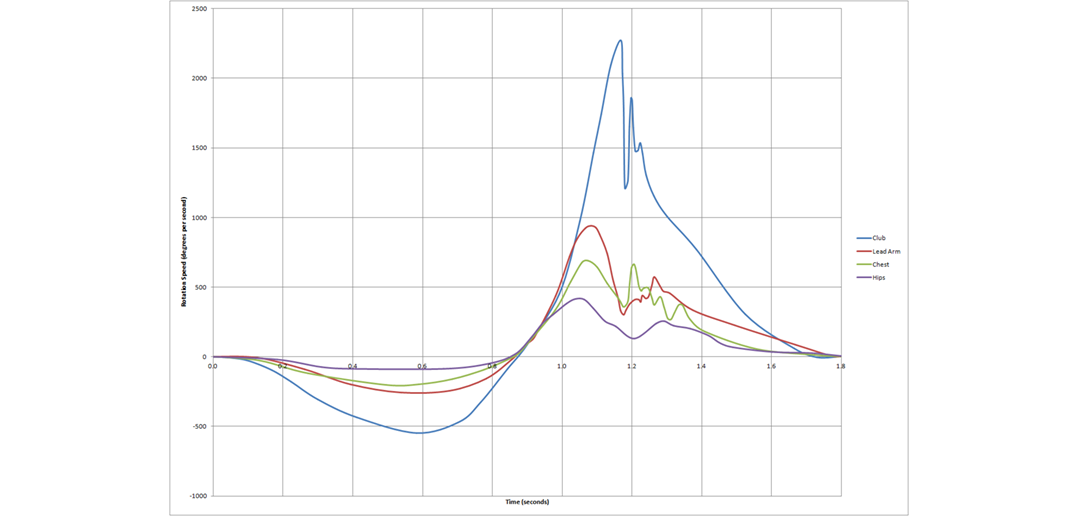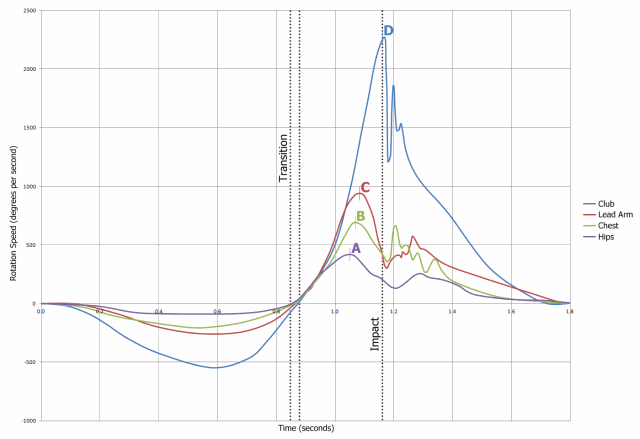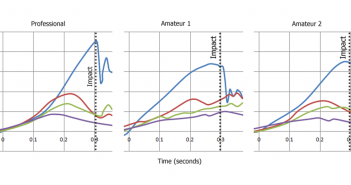This article describes the biomechanical sequence of the golf swing — the ideal sequence and timing of the motions of each part of your body during each phase of the swing.
The information presented here is the result of our extensive analysis, over a number of years, of the golf swings of elite players using the latest 3D motion capture tools and techniques.
3D motion capture technology has advanced enormously in recent years. It is has profoundly changed our understanding of golf swing biomechanics, and it is changing the way that instructors and players look at the swing. The technology can track the precise movements of every part of the golfer’s body during every millisecond of the golf swing. It provides 3D traces and acceleration profiles that, armed with our new understanding of biomechanics, can instantly reveal the underlying causes of a golfer’s swing inefficiencies.
Don’t worry, you won’t need a PhD in Biomechanics to understand all of this. In fact, you don’t really need to know this stuff to be a great golfer — most of the guys on Tour couldn’t explain any of this to you. However, the knowledge presented here will help you to better understand the golf swing, and it may be a very useful tool in helping you to improve.
All great golfers have, basically, the same well-timed sequence of movements. Tour players may not know the details, but they learned from a young age how the correct movements feel. If you’re reading this then you’re probably trying to improve as a golfer, and your current sequence is probably very different to the model described here. This article will help you to understand the differences, and help you on the road to discovering what a great golf swing feels like.
This section of the site is devoted to the “what” and “why” of a great golf swing — what it looks like, what happens and in what order, and why it works that way. The “how” — how to move and how to learn and ingrain a great swing — is presented in the Swing like a Champion system.
Much of what we describe here is discussed in the context of what elite golfers do in their swings, complete with graphs, pictures and videos of their motion. But what any given golfer does is not necessarily biomechanically perfect, so we choose real-life examples very carefully.
Unlike other golf tuition, the lessons presented in the Swing like a Champion system are all based strictly on what is biomechanically correct, and not just on what works for other people.
The Golf Swing Kinematic Sequence
For optimum performance of the golf swing, there is a precisely timed sequence of body movements. This sequence progresses from the large, inner parts of the body to the smaller, outer parts. When this sequence and timing are correct, power and speed are created, transferred and amplified by each segment of the body, up the kinetic chain, to deliver the club to the ball in the most effective way possible. This precisely timed sequence is also referred to in biomechanics literature as “proximal to distal sequencing”, “kinetic linking” or the “kinematic sequence”.
The best way to understand the kinematic sequence of the golf swing is by considering the movement of the major segments of your body; the hips (pelvis), the chest (thorax or upper body), the arms and the golf club.
We can see the sequence clearly when we view a graph of the rotational speed of each segment throughout the swing:
Figure 1. The Golf Swing Kinematic Sequence
Note that negative rotational speeds indicate clockwise movement (for a right handed golfer), or the backswing. Positive rotational speeds indicate anti-clockwise movement, or the downswing and follow-through.
If you have any questions or comments about this or other articles on Golf Loopy, please send us an email.
We’ll now discuss in detail what this graph tells us for each phase of the golf swing, starting with Golf Swing Sequence and Timing – The Downswing.
You May Also Like…
Golf Swing Sequence and Timing – The Transition, an analysis of the kinematic sequence of the Transition phase.
Golf Swing Sequence and Timing – Common Faults, which gives a comparison of the kinematic sequence for typical amateurs and Tour Pros, showing the common flaws that may plague your own golf swing.
Golf Lag and the Compound Pendulum, which describes how you can use physics to generate more speed, accuracy and consistency in your golf swing, with less effort and less strain on your body.
Introduction to the Swing like a Champion System
Overview of a Great Golf Swing, which summarises the correct movements in a great golf swing.
Golf Anatomy and Kinesiology, a collection of articles describing the roles of the muscles involved in the golf swing.
Ground reaction force (GRF), which describes how driving into the ground with your legs transfers power back up through your body.
Kinetic Chain, which describes how the different parts of your body act to transfer energy from the ground to the golf ball.





